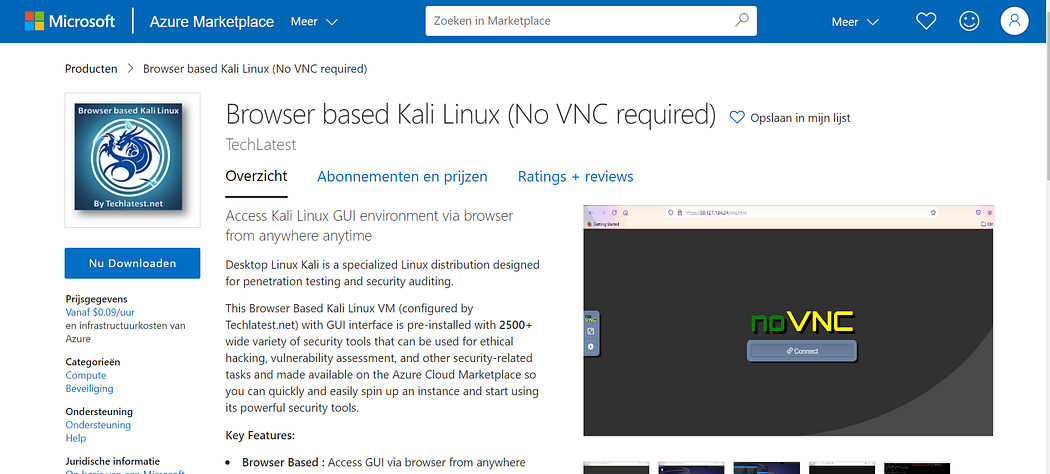How to Install Browser-Based Kali Linux with 2500+ security apps From Azure Marketplace
How to Install Browser-Based Kali Linux with 2500+ security apps From Azure Marketplace
Introduction
Browser-based Kali Linux refers to a version of the Kali Linux operating system that can be run directly from a web browser, without the need for installation or a separate virtual machine. It is a cloud-based version of Kali Linux, which means that it runs on remote servers and can be accessed via a web browser from any device with an internet connection.
The browser-based version of Kali Linux offers a number of advantages, including easy accessibility and the ability to run on low-end hardware. It also allows users to quickly test and experiment with Kali Linux tools without the need to install the OS on their local machine.
In this article, we will introduce three topics
Browser**-Based Kali Linux** — Browser-based Kali Linux is a cloud-based version of the Kali Linux operating system that can be accessed via a web browser.
Azure — Azure is a cloud computing platform and set of services provided by Microsoft for building, deploying, and managing applications and services through a global network of data centres.
Step by Step guide — Guide on how to set up Browser Based Kali Linux On Azure.
Step by Step Guide to install, setup, and run Browser Based Kali Linux On Azure
- Step 1
Open Browser-based Kali Linux listing on Azure Marketplace.

Click on Get It Now.
Select a Resource group for your virtual machine.
- Step 2
Click on the Create Button*. You may need to log in to your Azure account if not already logged in.*

Select a Region where you want to launch the VM(such as East US).

Optionally change the number of cores and amount of memory.
Select the Authentication type as Password and enter Username as ubuntu and the Password of your choice.

Optionally change the OS disk type.

Optionally change the network and subnetwork names. Be sure that whichever network you specify has ports 22 (for SSH) and 3389 (for RDP) exposed.

Optionally go to the Management, Advanced and Tags tabs for any advanced settings you want for the VM.
Click on Review + Create and then click on Create when you are done.
Virtual Machine will begin deploying.

- Step 3
A summary page displays when the virtual machine is successfully created. Click on Go to resource link to go to the resource page. It will open an overview page of the virtual machine.

- Step 4
In the left navigation pane, select Run command, select RunShellScript and enter the following command to change the password of the VM.
sudo echo ubuntu:yourpassword | chpasswd


- Step 5
To access the Kali Linux GUI environment via a browser. To do so, Copy the Public IP address of the VM from the VM’s details page and enter the address as vm_public_ip/vnc.html in the browser. Hit enter.
Note: Please use HTTPS and not HTTP in the URL when accessing Kali Linux GUI, e.g. 52.87.221.85/vnc.html.
- Step 6
While accessing GUI via browser, an SSL certification warning will be shown. Click on Show details and then select Wish to Continue.


- Step 7
After accepting the SSL certification warning it will show you the below screen. Please click on Connect button.

- Step 8
Now you are connected to of box Kali GUI Linux environment via Browser*.*

- Step 9
After your first login, Open the terminal and run the below command to change the root user password.
x11vnc -storepasswd

- Step 10
Once the password is set, reboot the VM and re-login with the root user and new password.

- Step 11
Now you are connected to out-of-box Kali GUI Linux via a browser which comes with preinstalled Kali tools and apps such as Information Gathering, Vulnerability Analysis, web application analysis, also tools like development, you can explore all this is just amazing.

- Step 12
To SSH to the VM copy the public IP of the VM and paste it in putty. Log in to the instance using SSH via key-based authentication. Use “ubuntu” as userid (refer to Putty Guide for details on how to connect using Putty/SSH).
- Step 13
Run the below command to connect to the Kali terminal from the SSH command prompt.
sudo docker exec -it kali-linux /bin/bash

- Step 14
If the above command returns an “Error response from daemon:” error, then run the below command to start the Kali container and then run the above command again.
sudo docker start kali-linux
Conclusion
The blog provides a comprehensive step-by-step guide on how to set up and run Browser Based Kali Linux on Azure. The blog highlights the advantages of using the browser-based version of Kali Linux, including easy accessibility and the ability to run on low-end hardware. It also provides instructions on how to change the password of the VM and access the Kali Linux GUI environment via a browser. Additionally, the blog discusses how to SSH to the VM and connect to the Kali terminal from the SSH command prompt. Overall, this guide can be useful for anyone looking to experiment with Kali Linux tools without the need to install the OS on their local machine.
